A Land Evaluation Framework for Agricultural Diversification
Abstract
:1. Introduction
2. Materials and Methods
2.1. Data
2.2. Computational Aspects
2.3. Deriving the Indices
2.4. Accounting for Intraspecies Variation
3. Results
Intraspecies Test
4. Discussion
4.1. Intraspecies Variation
4.2. Combined Suitability Assessment
4.3. Combining with Traditional Land System Models
4.4. Limitations in Method, Data, and Computational Aspects
5. Conclusions
Author Contributions
Funding
Conflicts of Interest
Appendix A
| Name | Rainfall_ OptMx mm | Rainfall_ OptMn mm | Rainfall_ AbsMx mm | Rainfall_ AbsMn mm | Temp_ OptMx C | Temp_ OptMn C | Temp_ AbsMx C | Temp_ AbsMn C | Mn day | Mx day | Deep Depth | Medium Depth | Low Depth | pH Opt Max | pH Opt Min | pH Abs Max | pH Abs Min | Heavy Texture | Medium Texture | Light Texture |
|---|---|---|---|---|---|---|---|---|---|---|---|---|---|---|---|---|---|---|---|---|
| Akee | 4000 | 2000 | 6000 | 700 | 27 | 24 | 34 | 20 | 150 | 365 | 1 | 0 | 0 | 6.5 | 5.5 | 8 | 4.3 | 1 | 1 | 1 |
| Avocado | 2000 | 500 | 2500 | 300 | 40 | 14 | 45 | 10 | 365 | 365 | 1 | 0 | 0 | 5.8 | 5 | 7 | 4.5 | 0 | 1 | 0 |
| Bam.groundnut | 1400 | 750 | 3000 | 300 | 30 | 19 | 38 | 16 | 90 | 180 | 0 | 1 | 0 | 6.5 | 5 | 7 | 4.3 | 0 | 0 | 1 |
| Barley | 1000 | 500 | 2000 | 200 | 20 | 15 | 40 | 2 | 90 | 240 | 1 | 0 | 0 | 7.5 | 6.5 | 8 | 6 | 0 | 1 | 0 |
| Black Gram | 900 | 650 | 2430 | 530 | 35 | 22 | 40 | 8 | 60 | 130 | 1 | 0 | 0 | 6.5 | 5.5 | 7.5 | 4.5 | 1 | 1 | 0 |
| Breadfruit | 3000 | 1500 | 3500 | 1000 | 33 | 21 | 40 | 16 | 90 | 365 | 1 | 0 | 0 | 6.5 | 5.5 | 8.7 | 4.3 | 1 | 1 | 1 |
| Carob | 1000 | 400 | 2000 | 200 | 32 | 20 | 39 | 10 | 330 | 365 | 0 | 0 | 1 | 7.5 | 6 | 9 | 5 | 0 | 1 | 1 |
| Common Wheat | 900 | 750 | 1600 | 300 | 23 | 15 | 27 | 5 | 90 | 250 | 0 | 1 | 0 | 7 | 6 | 8.5 | 5.5 | 0 | 1 | 0 |
| Cowpea | 1500 | 500 | 4100 | 300 | 35 | 25 | 40 | 15 | 30 | 240 | 0 | 1 | 0 | 7.5 | 5.5 | 8.8 | 4 | 0 | 1 | 1 |
| Egyptian sesban | 2000 | 800 | 2500 | 350 | 28 | 18 | 45 | 10 | 120 | 365 | 0 | 1 | 0 | 7 | 5 | 9.9 | 4 | 1 | 1 | 1 |
| Finger Millet | 1100 | 500 | 4300 | 300 | 30 | 18 | 35 | 8 | 75 | 180 | 0 | 1 | 0 | 7 | 6 | 8.2 | 5.5 | 0 | 1 | 0 |
| Fonio | 1600 | 900 | 2800 | 400 | 27 | 22 | 31 | 18 | 90 | 130 | 0 | 1 | 0 | 6.5 | 5.5 | 7.1 | 4.5 | 0 | 1 | 1 |
| Foxtail Millet | 700 | 500 | 4000 | 300 | 26 | 16 | 35 | 5 | 60 | 120 | 1 | 0 | 0 | 6.8 | 6 | 8.3 | 5.5 | 0 | 1 | 1 |
| Guava | 3000 | 1000 | 5000 | 400 | 33 | 20 | 45 | 10 | 150 | 365 | 0 | 1 | 0 | 7.5 | 5.5 | 8.5 | 4 | 0 | 1 | 0 |
| Hyacinth Bean | 1000 | 600 | 2500 | 200 | 32 | 18 | 38 | 3 | 70 | 300 | 0 | 1 | 0 | 7.5 | 5 | 8 | 4.5 | 1 | 1 | 1 |
| Indian Mulberry | 3000 | 1500 | 4200 | 700 | 30 | 24 | 36 | 12 | 365 | 365 | 1 | 0 | 0 | 6.5 | 5 | 7 | 4.3 | 0 | 1 | 0 |
| Java-plum | 6000 | 1500 | 9900 | 800 | 32 | 20 | 48 | 12 | 150 | 365 | 1 | 0 | 0 | 7 | 5.5 | 8 | 4.5 | 0 | 1 | 1 |
| Leucaena | 3000 | 600 | 5000 | 250 | 32 | 20 | 42 | 10 | 180 | 365 | 1 | 0 | 0 | 7.7 | 6 | 8.5 | 5 | 1 | 1 | 0 |
| Paddy | 2000 | 1500 | 4000 | 1000 | 30 | 20 | 36 | 10 | 80 | 180 | 0 | 1 | 0 | 7 | 5.5 | 9 | 4.5 | 1 | 1 | 1 |
| Pearl Millet | 900 | 400 | 1700 | 200 | 35 | 25 | 40 | 12 | 60 | 120 | 1 | 0 | 0 | 6.5 | 5 | 8.3 | 4.5 | 0 | 1 | 1 |
| Pigeon Pea | 1500 | 600 | 4000 | 400 | 38 | 18 | 45 | 10 | 90 | 365 | 1 | 0 | 0 | 7 | 5 | 8.4 | 4.5 | 0 | 1 | 1 |
| Pomegranate | 1200 | 900 | 4200 | 400 | 32 | 23 | 40 | 8 | 180 | 365 | 1 | 0 | 0 | 7.5 | 6.5 | 8.5 | 5.8 | 1 | 1 | 0 |
| Pomelo | 2500 | 1500 | 4000 | 700 | 32 | 23 | 40 | 12 | 365 | 365 | 1 | 0 | 0 | 7 | 5.5 | 8 | 4.5 | 0 | 1 | 0 |
| Proso Millet | 750 | 500 | 1000 | 200 | 32 | 20 | 45 | 15 | 55 | 280 | 0 | 1 | 0 | 6.5 | 6 | 8.2 | 5.2 | 0 | 1 | 0 |
| Quinoa | 1000 | 500 | 2600 | 250 | 18 | 14 | 35 | 2 | 90 | 240 | 0 | 1 | 0 | 8 | 5.5 | 9.5 | 4.5 | 1 | 1 | 1 |
| Soursop | 2200 | 1200 | 4200 | 800 | 30 | 20 | 36 | 13 | 180 | 365 | 1 | 0 | 0 | 6.5 | 5.5 | 8 | 4.5 | 1 | 1 | 0 |
| Soybean | 1500 | 600 | 1800 | 450 | 33 | 20 | 38 | 10 | 75 | 180 | 0 | 1 | 0 | 6.5 | 5.5 | 8.4 | 4.5 | 0 | 1 | 0 |
| Sugarcane | 2000 | 1500 | 5000 | 1000 | 37 | 24 | 41 | 15 | 210 | 365 | 1 | 0 | 0 | 8 | 5 | 9 | 4.5 | 0 | 1 | 0 |
| Taro (Cocoyam) | 2700 | 1800 | 4100 | 1000 | 28 | 21 | 35 | 10 | 180 | 300 | 0 | 1 | 0 | 6.5 | 5.5 | 8.2 | 4.3 | 0 | 1 | 0 |
| Teff | 1200 | 600 | 2500 | 300 | 28 | 22 | 30 | 2 | 65 | 150 | 0 | 0 | 1 | 6.5 | 5.5 | 8.2 | 5 | 0 | 1 | 1 |
| Velvet Bean | 2000 | 1000 | 3100 | 400 | 30 | 20 | 34 | 10 | 90 | 270 | 0 | 1 | 0 | 7 | 5 | 8 | 4 | 0 | 1 | 1 |
| White Pea | 1300 | 500 | 3000 | 320 | 28 | 10 | 32 | 4 | 100 | 190 | 0 | 1 | 0 | 7.5 | 6 | 8.3 | 4.5 | 1 | 1 | 1 |
| Winged Bean | 2500 | 1000 | 4100 | 500 | 30 | 18 | 40 | 14 | 50 | 270 | 1 | 0 | 0 | 7 | 5.5 | 8.5 | 4.3 | 0 | 1 | 0 |
| Yautia | 2000 | 1000 | 6000 | 750 | 28 | 20 | 35 | 10 | 120 | 365 | 0 | 1 | 0 | 7 | 5.5 | 7.8 | 4.5 | 0 | 1 | 0 |
| Mashua | 1200 | 1000 | 1600 | 700 | 20 | 12 | 24 | 4 | 180 | 240 | 0 | 1 | 0 | 7 | 6 | 7.5 | 5.3 | 1 | 1 | 1 |
| Water Yam | 4000 | 1200 | 8000 | 700 | 32 | 20 | 40 | 14 | 220 | 300 | 1 | 0 | 0 | 6.5 | 5.5 | 8.5 | 4.8 | 0 | 1 | 1 |
| Cassava | 1500 | 1000 | 5000 | 500 | 29 | 20 | 35 | 10 | 180 | 365 | 0 | 1 | 0 | 8 | 5.5 | 9 | 4 | 0 | 1 | 1 |
| Oca | 1300 | 800 | 2150 | 570 | 24 | 12 | 28 | 5 | 180 | 270 | 0 | 1 | 0 | 7 | 6 | 7.8 | 5.3 | 0 | 1 | 1 |
| Moringa | 2200 | 700 | 2600 | 400 | 35 | 20 | 48 | 7 | 210 | 330 | 1 | 0 | 0 | 7 | 5.5 | 8.5 | 5 | 0 | 1 | 1 |
| Tepary Bean | 1000 | 600 | 1700 | 300 | 30 | 20 | 38 | 8 | 60 | 120 | 0 | 1 | 0 | 7 | 6 | 8 | 5 | 0 | 1 | 1 |
Appendix B
| Texture Keyword | Common Names of Soils (General Texture) | Sand | Silt | Clay | Textural Class | |||
|---|---|---|---|---|---|---|---|---|
| Light | Sandy soils (Coarse texture) | 86 | 100 | 0 | 14 | 0 | 10 | Sand |
| 70 | 86 | 0 | 30 | 0 | 15 | Loamy sand | ||
| Medium | Loamy soils (Medium texture) | 23 | 52 | 28 | 50 | 7 | 27 | Loam |
| 20 | 50 | 74 | 88 | 0 | 27 | Silty loam | ||
| 0 | 20 | 88 | 100 | 0 | 12 | Silt | ||
| Heavy | Clayey soils (Fine texture) | 45 | 65 | 0 | 20 | 35 | 55 | Sandy clay |
| 0 | 20 | 40 | 60 | 40 | 60 | Silty clay | ||
| 0 | 45 | 0 | 40 | 40 | 100 | Clay | ||
References
- Azam-Ali, S.N. Fitting underutilised crops within research-poor environments: Lessons and approaches. S. Afr. J. Plant Soil 2010, 27, 293–298. [Google Scholar] [CrossRef] [Green Version]
- Mabhaudhi, T.; Modi, A.T. Sowing the seeds of knowledge on under-utilised crops: Indigenous crops - feature. Water Wheel 2016, 15, 40–41. [Google Scholar]
- Dent, D.; Young, A. Soil Survey and Land Evaluation; E & FN Spon Allen & Unwin: London, UK, 1981; ISBN 978-0-419-15960-5. [Google Scholar]
- Mueller, L.; Schindler, U.; Mirschel, W.; Shepherd, T.G.; Ball, B.C.; Helming, K.; Rogasik, J.; Eulenstein, F.; Wiggering, H. Assessing the productivity function of soils. A review. Agron. Sustain. Dev. 2010, 30, 601–614. [Google Scholar] [CrossRef]
- FAO. Soil resources development and conservation service, land and water development division, FAO. A framework for land evaluation. In Soils Bulletin; Food and Agriculture Organisation of the United Nations: Rome, Italy, 1976; Volume 32. [Google Scholar]
- Malone, B.P.; Kidd, D.B.; Minasny, B.; McBratney, A.B. Taking account of uncertainties in digital land suitability assessment. PeerJ 2015, 3, e1366. [Google Scholar] [CrossRef] [PubMed]
- Manna, P.; Basile, A.; Bonfante, A.; De Mascellis, R.; Terribile, F. Comparative Land Evaluation approaches: An itinerary from FAO framework to simulation modelling. Geoderma 2009, 150, 367–378. [Google Scholar] [CrossRef]
- Johnson, A.K.L.; Cramb, R.A. Development of a simulation based land evaluation system using crop modelling, expert systems and risk analysis. Soil Use Manag. 1991, 7, 239–246. [Google Scholar] [CrossRef]
- Recatalá Boix, L.; Zinck, J.A. Land-Use Planning in the Chaco Plain (Burruyacú, Argentina). Part 1: Evaluating Land-Use Options to Support Crop Diversification in an Agricultural Frontier Area Using Physical Land Evaluation. Environ. Manag. 2008, 42, 1043–1063. [Google Scholar]
- Qiu, F.; Chastain, B.; Zhou, Y.; Zhang, C.; Sridharan, H. Modeling land suitability/capability using fuzzy evaluation. GeoJournal 2014, 79, 167–182. [Google Scholar] [CrossRef]
- Gerwin, W.; Repmann, F.; Galatsidas, S.; Vlachaki, D.; Gounaris, N.; Baumgarten, W.; Volkmann, C.; Keramitzis, D.; Kiourtsis, F.; Freese, D. Assessment and quantification of marginal lands for biomass production in Europe using soil-quality indicators. Soil 2018, 4, 267–290. [Google Scholar] [CrossRef] [Green Version]
- Rötter, R.P.; Carter, T.R.; Olesen, J.E.; Porter, J.R. Crop–climate models need an overhaul. Nat. Clim. Chang. 2011, 1, 175–177. [Google Scholar]
- Hoogenboom, G.; Pérez, C.L.; Rossiter, D.; Laake, P.V. Chapter 13 - Biophysical Agricultural Assessment and Management Models for Developing Countries. In Quantifying Sustainable Development; Hall, C.A.S., Perez, C.L., Leclerc, G., Eds.; Academic Press: San Diego, CA, USA, 2000; ISBN 978-0-12-318860-1. [Google Scholar]
- Manners, R.; van Etten, J. Are agricultural researchers working on the right crops to enable food and nutrition security under future climates? Glob. Environ. Chang. 2018, 53, 182–194. [Google Scholar] [CrossRef]
- Ramirez-Villegas, J.; Jarvis, A.; Läderach, P. Empirical approaches for assessing impacts of climate change on agriculture: The EcoCrop model and a case study with grain sorghum. Agric. For. Meteorol. 2013, 170, 67–78. [Google Scholar] [CrossRef]
- Bonfante, A.; Monaco, E.; Alfieri, S.M.; De Lorenzi, F.; Manna, P.; Basile, A.; Bouma, J. Climate Change Effects on the Suitability of an Agricultural Area to Maize Cultivation. In Advances in Agronomy; Elsevier: Amsterdam, The Netherlands, 2015; Volume 133, pp. 33–69. ISBN 978-0-12-803052-3. [Google Scholar]
- Zhao, C.; Liu, B.; Xiao, L.; Hoogenboom, G.; Boote, K.J.; Kassie, B.T.; Pavan, W.; Shelia, V.; Kim, K.S.; Hernandez-Ochoa, I.M.; et al. A SIMPLE crop model. Eur. J. Agron. 2019, 104, 97–106. [Google Scholar] [CrossRef]
- Hijmans, R.J.; Guarino, L.; Cruz, M.; Rojas, E. Computer tools for spatial analysis of plant genetic resources data: 1. DIVA-GIS. Plant Genet. Resour. Newslett. 2001, 127, 15–19. [Google Scholar]
- Piikki, K.; Winowiecki, L.; Vågen, T.-G.; Ramirez-Villegas, J.; Söderström, M. Improvement of spatial modelling of crop suitability using a new digital soil map of Tanzania. S. Afr. J. Plant Soil 2017, 34, 243–254. [Google Scholar] [CrossRef]
- Velazco, S.J.E.; Galvão, F.; Villalobos, F.; De Marco Júnior, P. Using worldwide edaphic data to model plant species niches: An assessment at a continental extent. PLoS ONE 2017, 12, e0186025. [Google Scholar] [CrossRef] [Green Version]
- Kim, H.; Hyun, S.W.; Hoogenboom, G.; Porter, C.H.; Kim, K.S. Fuzzy Union to Assess Climate Suitability of Annual Ryegrass (Lolium multiflorum), Alfalfa (Medicago sativa) and Sorghum (Sorghum bicolor). Sci. Rep. 2018, 8, 10220. [Google Scholar] [CrossRef]
- Zabel, F.; Putzenlechner, B.; Mauser, W. Global Agricultural Land Resources – A High Resolution Suitability Evaluation and Its Perspectives until 2100 under Climate Change Conditions. PLoS ONE 2014, 9, e107522. [Google Scholar] [CrossRef] [Green Version]
- Estes, L.D.; Bradley, B.A.; Beukes, H.; Hole, D.G.; Lau, M.; Oppenheimer, M.G.; Schulze, R.; Tadross, M.A.; Turner, W.R. Comparing mechanistic and empirical model projections of crop suitability and productivity: implications for ecological forecasting: Crop model intercomparison. Glob. Ecol. Biogeogr. 2013, 22, 1007–1018. [Google Scholar] [CrossRef]
- Mabhaudhi, T.; Chimonyo, V.; Albert, M. Status of Underutilised Crops in South Africa: Opportunities for Developing Research Capacity. Sustainability 2017, 9, 1569. [Google Scholar] [CrossRef] [Green Version]
- Land and Water Development Division of FAO. EcoCrop Database. Available online: http://ecocrop.fao.org/ecocrop/srv/en/about (accessed on 26 March 2019).
- GBIF. Available online: https://www.gbif.org/ (accessed on 28 March 2019).
- International Institute of Tropical Agriculture Bambara Groundnut Collection. Available online: http://my.iita.org/accession2/collection.jspx;jsessionid=A73728F581D906CDF43B9DC1D554090A?id=8 (accessed on 11 March 2019).
- Fick, S.E.; Hijmans, R.J. WorldClim 2: new 1-km spatial resolution climate surfaces for global land areas: NEW CLIMATE SURFACES FOR GLOBAL LAND AREAS. Int. J. Climatol. 2017, 37, 4302–4315. [Google Scholar] [CrossRef]
- Hengl, T.; Mendes de Jesus, J.; Heuvelink, G.B.M.; Ruiperez Gonzalez, M.; Kilibarda, M.; Blagotić, A.; Shangguan, W.; Wright, M.N.; Geng, X.; Bauer-Marschallinger, B.; et al. SoilGrids250m: Global gridded soil information based on machine learning. PLoS ONE 2017, 12, e0169748. [Google Scholar] [CrossRef] [PubMed] [Green Version]
- USDA Soil Survey Manual; US Department of Agriculture: Washington, DC, USA, 1993.
- R Core Team. R: A Language and Environment for Statistical Computing; R Core Team: Vienna, Austria,, 2013. [Google Scholar]
- Global Biodiversity Information Facility. Available online: http://gbif.github.io/parsers/apidocs/org/gbif/api/vocabulary/BasisOfRecord.html (accessed on 26 March 2019).
- Jahanshiri, E. geoej/LEFAD. A Land Evaluation Framework for Agricultural Diversification; Crops For the Future Research Centre: Semenyih, Malaysia, 2020. [Google Scholar] [CrossRef]
- FAO Soil Texture Training Manual. Available online: http://www.fao.org/tempref/FI/CDrom/FAO_Training/FAO_Training/General/x6706e/x6706e06.htm (accessed on 20 March 2020).
- Heller, J.; Begemann, F.; Mushonga, J. Bambara groundnut, Vigna subterranea (L.) Verdc. Promoting the Conservation and Use of Underutilized and Neglected Crops; International Plant Genetic Resources Institute: Gatersleben, Germany, 1997; ISBN 978-92-9043-299-9. [Google Scholar]
- Monfreda, C.; Ramankutty, N.; Foley, J.A. Farming the planet: 2. Geographic distribution of crop areas, yields, physiological types, and net primary production in the year 2000: GLOBAL CROP AREAS AND YIELDS IN 2000. Global Biogeochem. Cycles 2008, 22. [Google Scholar] [CrossRef]
- Ramirez-Villegas, J.; Watson, J.; Challinor, A.J. Identifying traits for genotypic adaptation using crop models. J. Exp. Bot. 2015, 66, 3451–3462. [Google Scholar] [CrossRef]
- Díez, M.J.; De la Rosa, L.; Martín, I.; Guasch, L.; Cartea, M.E.; Mallor, C.; Casals, J.; Simó, J.; Rivera, A.; Anastasio, G.; et al. Plant Genebanks: Present Situation and Proposals for Their Improvement. the Case of the Spanish Network. Front. Plant Sci. 2018, 9, 1794. [Google Scholar] [CrossRef] [Green Version]
- Suhairi, T.A.S.T.M.; Jahanshiri, E.; Nizar, N.M.M. Multicriteria land suitability assessment for growing underutilised crop, bambara groundnut in Peninsular Malaysia. IOP Conf. Ser. Earth Environ. Sci. 2018, 169, 012044. [Google Scholar] [CrossRef]
- Fischer, G.; van Velthuizen, H.T.; Nachtergaele, F.O. Global Agro-Ecological Zones Assessment: Methodology and Results; IIASA: Laxenburg, Austria, 2000. [Google Scholar]
- You, L.; Wood, S.; Wood-Sichra, U. Generating plausible crop distribution maps for Sub-Saharan Africa using a spatially disaggregated data fusion and optimization approach. Agric. Syst. 2009, 99, 126–140. [Google Scholar] [CrossRef]
- Bouma, J.; Stoorvogel, J.J.; Sonneveld, M.P.W. Land Evaluation for Landscape Units. In Handbook of Soil Sciences Properties and Processes; CRC Press/Taylor & Francis: Boca Raton, FL, USA, 2011; ISBN 978-1-4398-0305-9. [Google Scholar]
- Karunaratne, A.S.; Azam-Ali, S.N.; Crout, N.M.J. BAMGRO: A SIMPLE MODEL TO SIMULATE THE RESPONSE OF BAMBARA GROUNDNUT TO ABIOTIC STRESS. Exp. Agric. 2011, 47, 489–507. [Google Scholar] [CrossRef]
- Yin, X.; van der Linden, C.G.; Struik, P.C. Bringing genetics and biochemistry to crop modelling, and vice versa. Eur. J. Agron. 2018, 100, 132–140. [Google Scholar] [CrossRef] [Green Version]
- Kijne, J.W.; Barker, R.; Molden, D.J. Water Productivity in Agriculture: Limits and Opportunities for Improvement; CABI: Wallingford, UK, 2003; ISBN 978-0-85199-669-1. [Google Scholar]
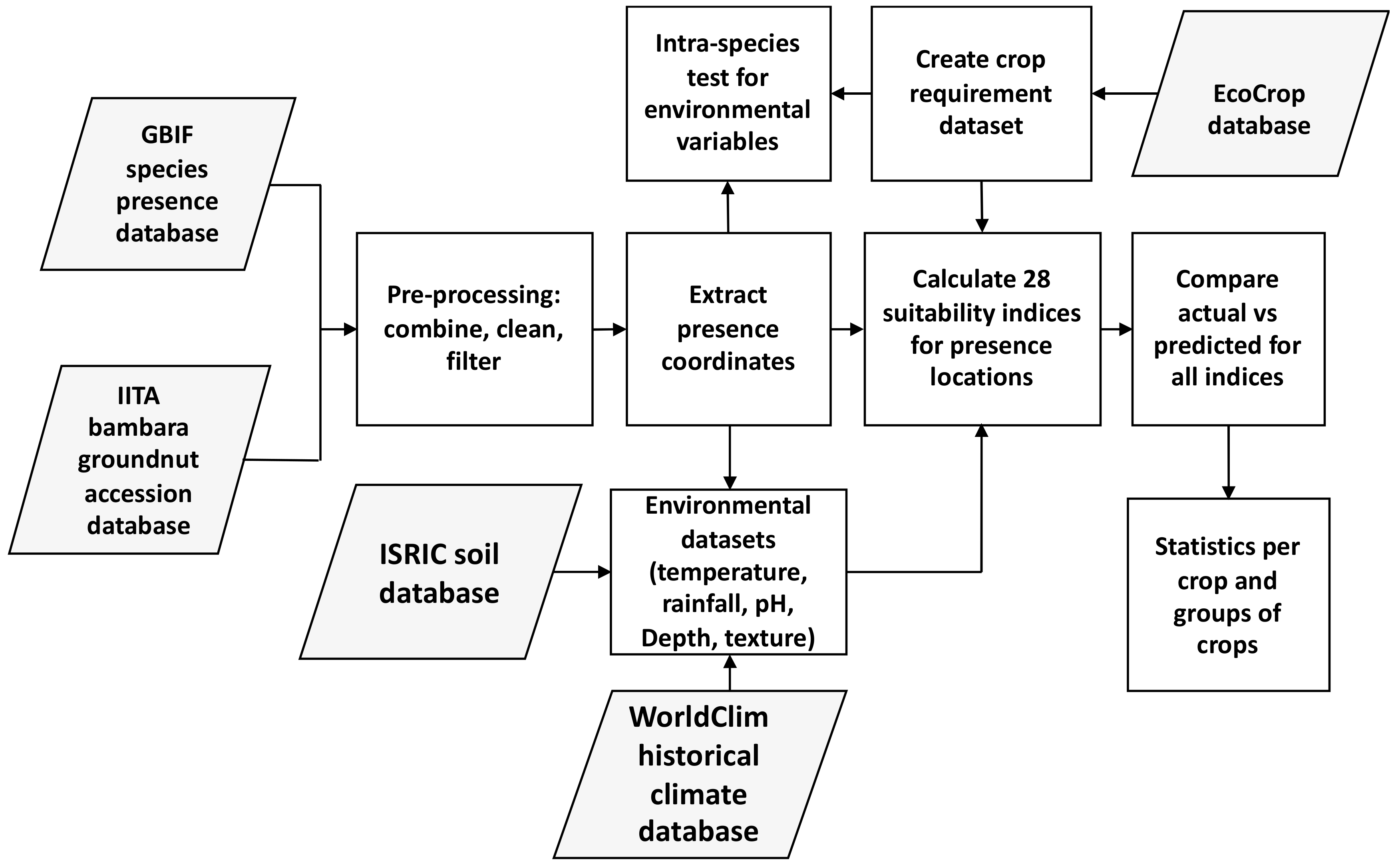
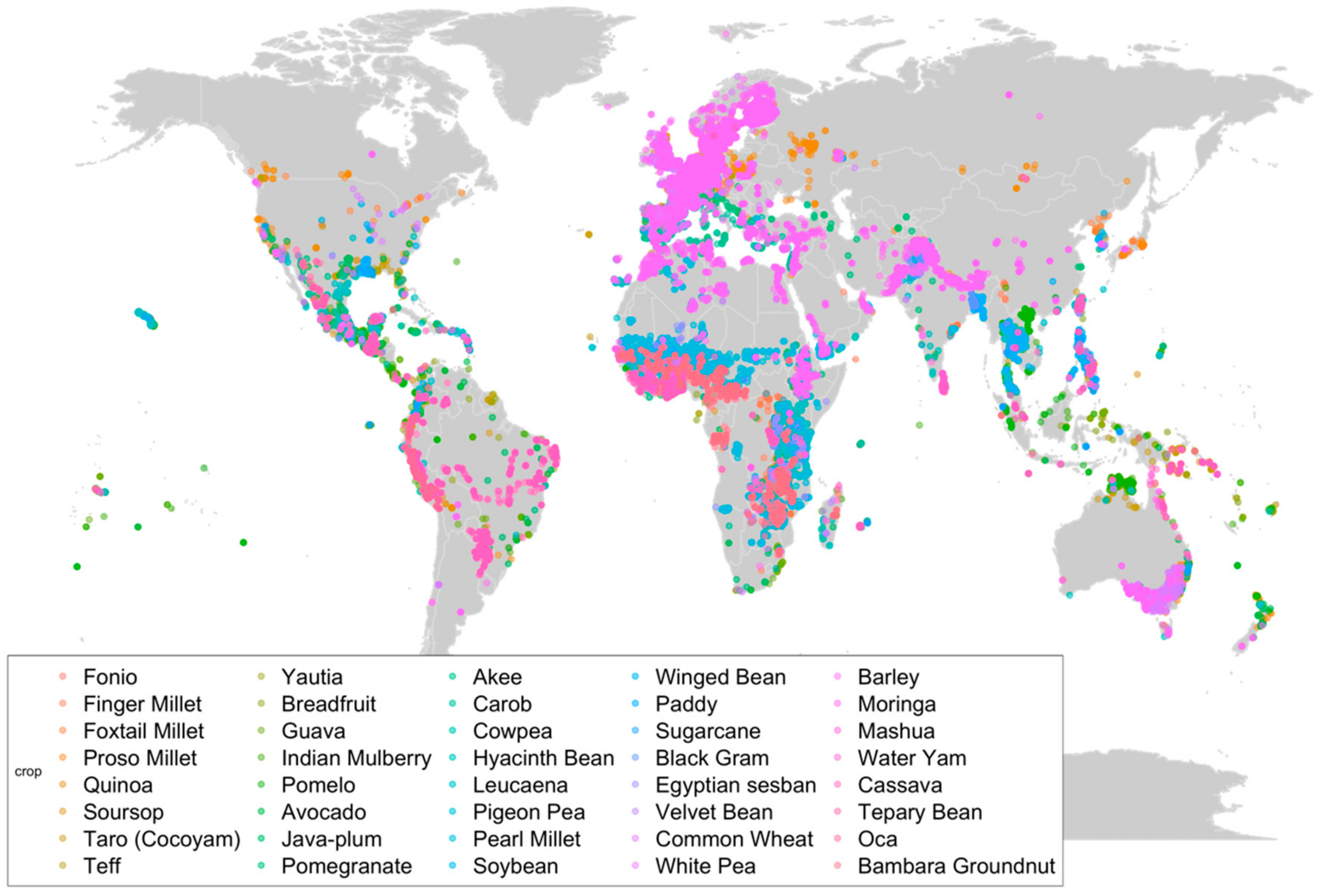
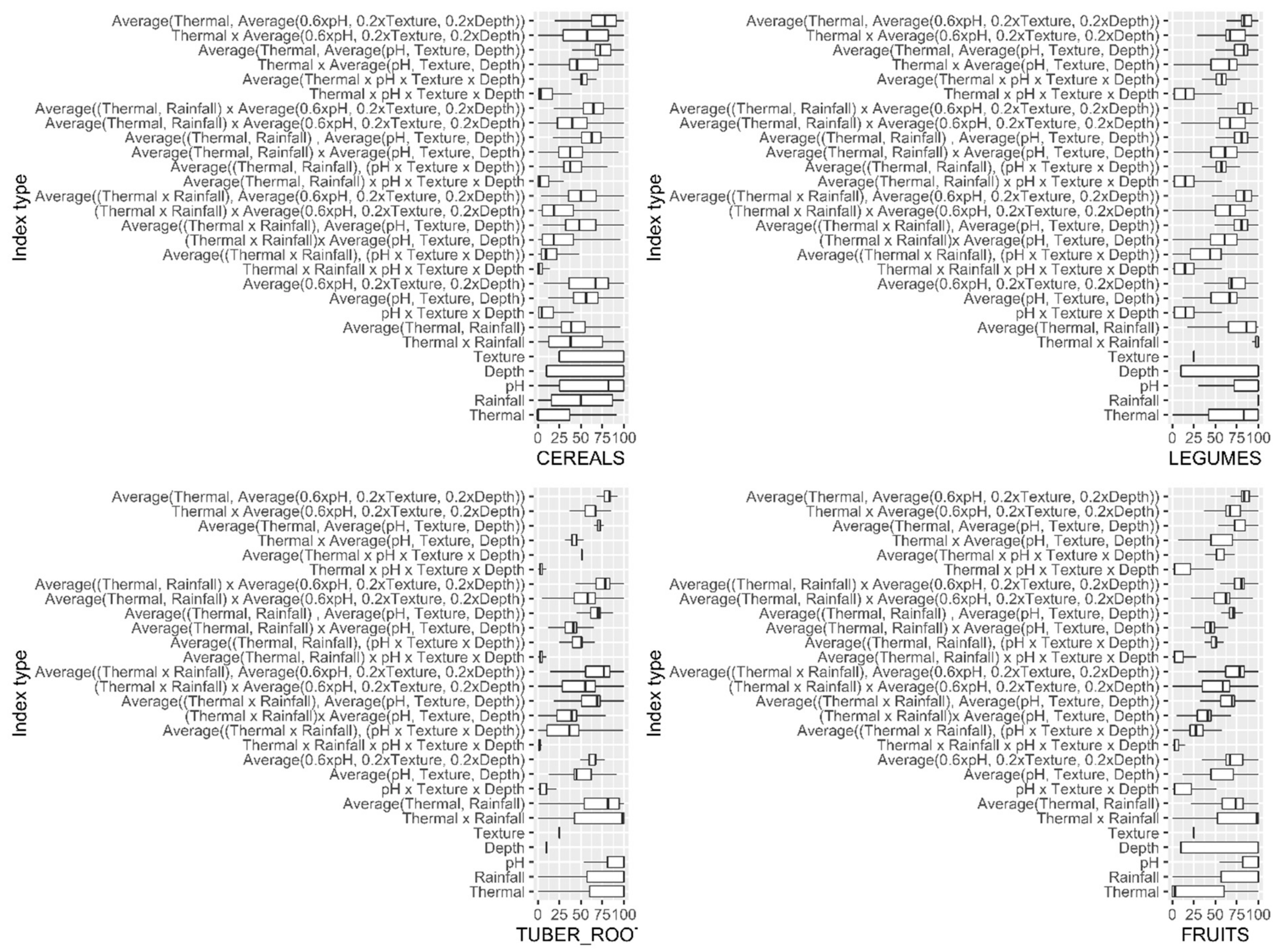

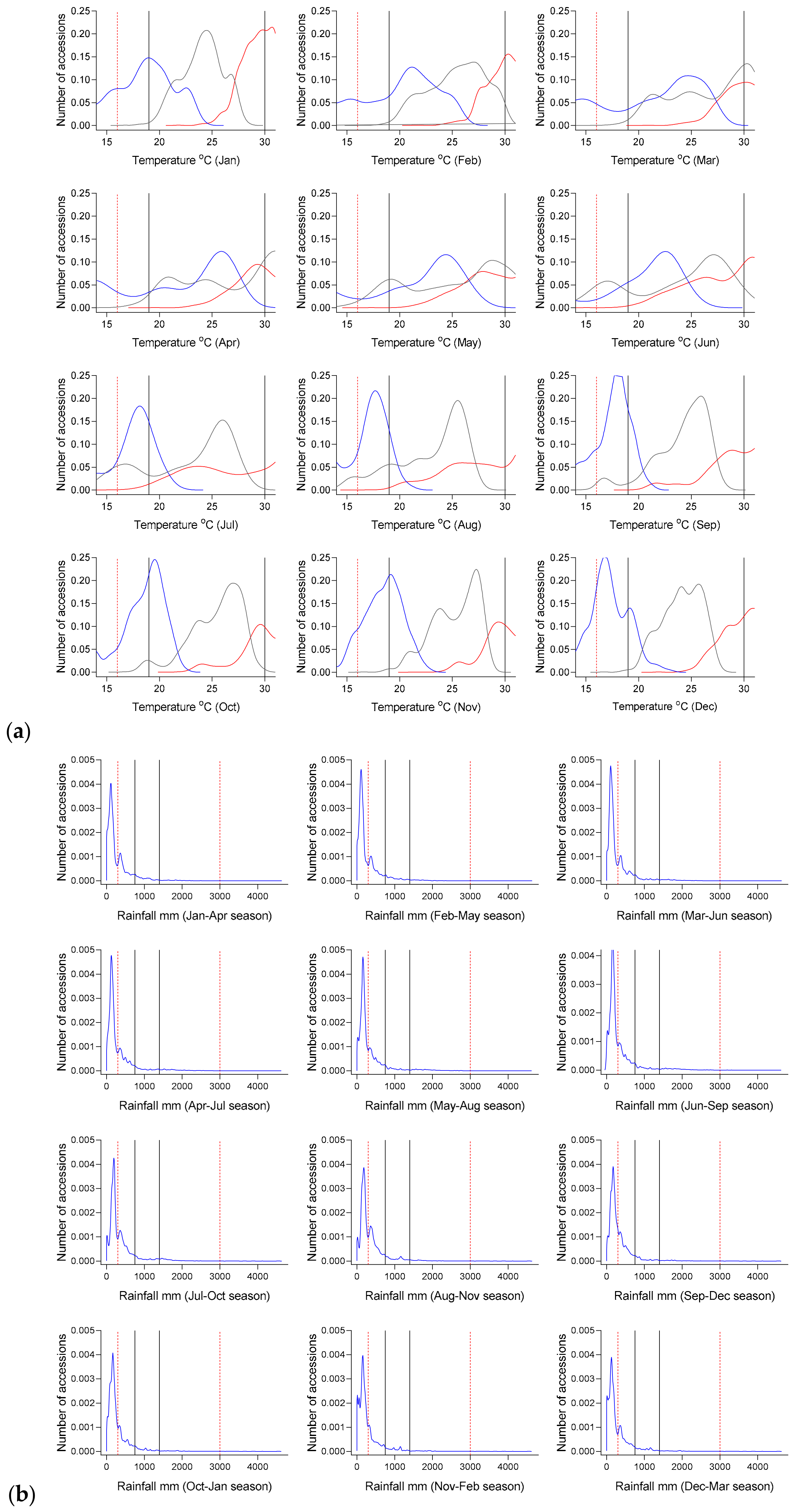
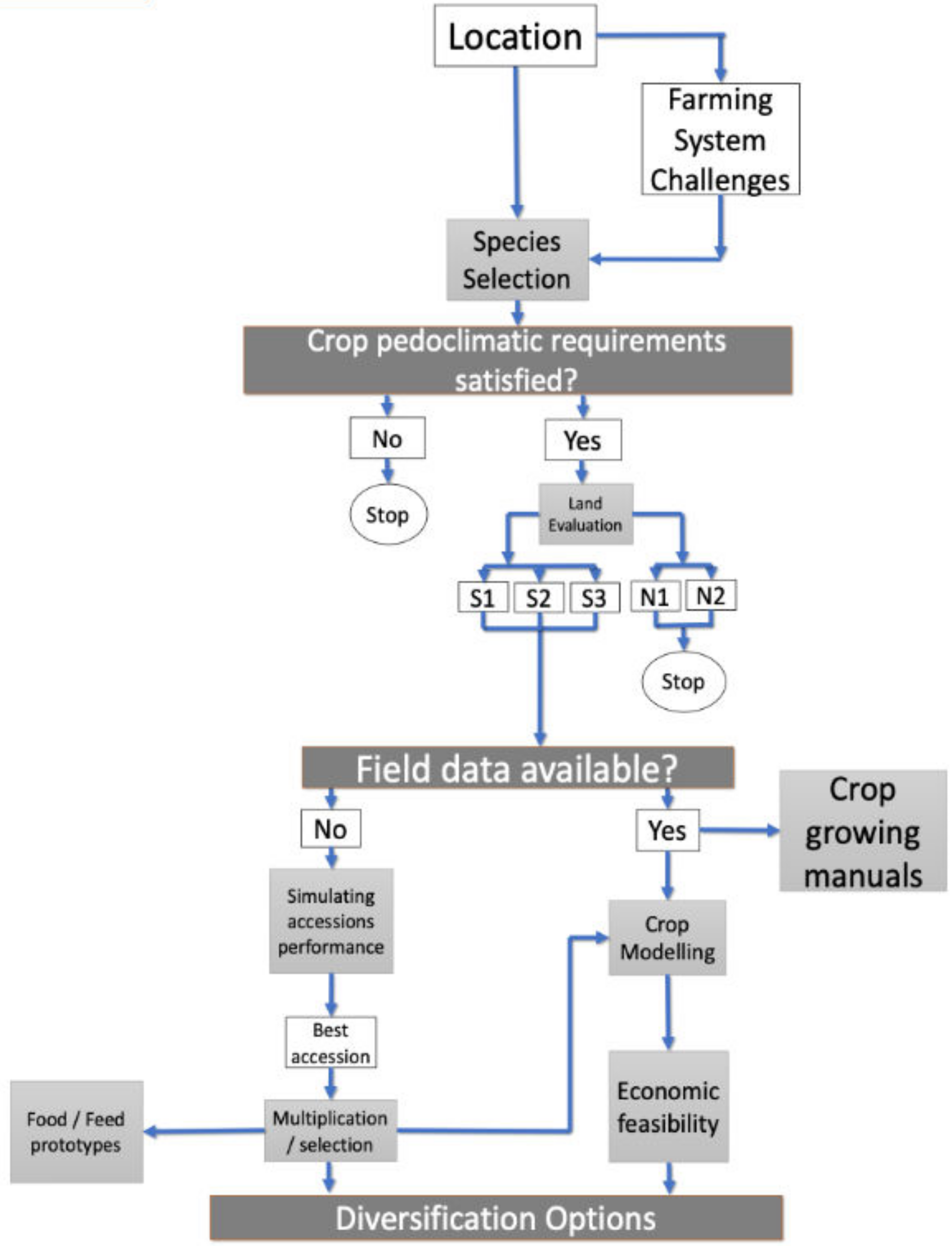
| Cereals, Pseudo-Cereals, and Grasses | Legumes and Vegetables |
| Barley—Hordeum vulgare L. Common Wheat—Triticum aestivum L. Finger Millet—Eleusine coracana Gaertn. Fonio—Digitaria exilis Stapf Foxtail Millet—Setaria italica P.Beauv. Paddy—Oryza sativa L. Pearl Millet—Pennisetum glaucum (L.) R.Br. Proso Millet—Panicum miliaceum L. Quinoa—Chenopodium quinoa Willd. Sugarcane—Saccharum officinarum L. Teff—Eragrostis tef (Zuccagni) Trotter | Black Gram—Vigna mungo (L.) Hepper Bambara groundnut—Vigna subterranea (L.) Verdc. Cowpea—Vigna unguiculata subsp. unguiculata Egyptian sesban—Sesbania sesban Merr. Hyacinth Bean—Lablab purpureus (L.) Sweet Leucaena—Leucaena leucocephala (Lam.) de Wit Pigeon pea—Cajanus cajan (L.) Millsp. Soybean—Glycine max (L.) Merr. Velvet Bean—Mucuna pruriens (L.) DC. White Pea—Lathyrus sativus L. Winged Bean—Psophocarpus tetragonolobus DC. Tepary Bean—Phaseolus acutifolius A.Gray Moringa—Moringa oleifera Lam |
| Tuber/Roots | Fruits |
| Taro (Cocoyam)—Colocasia esculenta (L.) Schott Yautia—Xanthosoma sagittifolium (L.) Schott Mashua—Tropaeolum tuberosum Ruiz & Pav Water Yam—Dioscorea alata L Cassava—Manihot esculenta Crantz Oca—Oxalis tuberosa Molina | Akee—Blighia sapida Kon. Avocado—Persea americana Mill. Breadfruit—Artocarpus altilis (Parkinson) Fosberg Carob—Ceratonia siliqua L. Guava—Psidium guajava L. Indian Mulberry—Morinda citrifolia L. Java-plum—Syzygium cumini (L.) Skeels Pomegranate—Punica granatum L. Pomelo—Citrus maxima (Burm.) Merr. Soursop—Annona muricata L. |
| Index | Formula |
|---|---|
| Thermal | |
| Rainfall | |
| pH | |
| Depth | |
| Texture | |
| Thermal × Rainfall | |
| Average (Thermal, Rainfall) | |
| pH × Texture × Depth | |
| Average (pH, Texture, Depth) | |
| Average (0.6 × pH, 0.2 × Texture, 0.2 × Depth) | |
| Thermal × Rainfall × pH × Texture × Depth | |
| Average ((Thermal × Rainfall), (pH × Texture × Depth)) | |
| (Thermal × Rainfall) × Average (pH, Texture, Depth) | |
| Average ((Thermal × Rainfall), Average (pH, Texture, Depth)) | |
| (Thermal × Rainfall) × Average (0.6 × pH, 0.2 × Texture, 0.2 × Depth) | |
| Average ((Thermal × Rainfall), Average (0.6 × pH, 0.2 × Texture, 0.2 × Depth)) | |
| Average (Thermal, Rainfall) × pH × Texture × Depth | |
| Average ((Thermal, Rainfall), (pH × Texture × Depth)) | |
| Average (Thermal, Rainfall) × Average (pH, Texture, Depth) | |
| Average ((Thermal, Rainfall), Average (pH, Texture, Depth)) | |
| Average (Thermal, Rainfall) × Average (0.6 × pH, 0.2 × Texture, 0.2 × Depth) | |
| Average ((Thermal, Rainfall), Average (0.6 × pH, 0.2 × Texture, 0.2 × Depth)) | |
| Thermal × pH × Texture × Depth | |
| Average (Thermal, (pH × Texture × Depth)) | |
| Thermal × Average (pH, Texture, Depth) | |
| Average (Thermal, Average (pH, Texture, Depth)) | |
| Thermal × Average (0.6 × pH, 0.2 × Texture, 0.2 × Depth) | |
| Average (Thermal, Average (0.6 × pH, 0.2 × Texture, 0.2 × Depth)) |
| No | Final Suitability Index | Mean | SD | Median | Min. | Max. |
|---|---|---|---|---|---|---|
| 1 | pH | 85 | 14 | 89 | 41 | 99 |
| 2 | Average (Thermal, Average (0.6 × pH, 0.2 × Texture, 0.2 × Depth)) | 82 | 7 | 82 | 58 | 92 |
| 3 | Average (Thermal, Average (pH, Texture, Depth)) | 77 | 8 | 75 | 53 | 88 |
| 4 | Average ((Thermal, Rainfall) × Average (0.6 × pH, 0.2 × Texture, 0.2 × Depth)) | 74 | 10 | 79 | 53 | 91 |
| 5 | Average ((Thermal, Rainfall), Average (pH, Texture, Depth)) | 69 | 10 | 70 | 47 | 87 |
| 6 | Average (0.6 × pH, 0.2 × Texture, 0.2 × Depth) | 69 | 9 | 70 | 43 | 85 |
| 7 | Rainfall | 66 | 30 | 80 | 1 | 98 |
| 8 | Average ((Thermal × Rainfall), Average (0.6 × pH, 0.2 × Texture, 0.2 × Depth)) | 66 | 17 | 73 | 29 | 91 |
| 9 | Thermal × Average (0.6 × pH, 0.2 × Texture, 0.2 × Depth) | 65 | 11 | 65 | 33 | 84 |
| 10 | Thermal × Rainfall | 63 | 31 | 76 | 1 | 98 |
| 11 | Average (Thermal, Rainfall) | 61 | 22 | 66 | 13 | 92 |
| 12 | Average ((Thermal × Rainfall), Average (pH, Texture, Depth)) | 61 | 16 | 65 | 22 | 86 |
| 13 | Average (pH, Texture, Depth) | 59 | 12 | 59 | 32 | 77 |
| 14 | Average (Thermal, Rainfall) × Average (0.6 × pH, 0.2 × Texture, 0.2 × Depth) | 56 | 15 | 61 | 28 | 83 |
| 15 | Thermal × Average (pH, Texture, Depth) | 55 | 14 | 51 | 28 | 76 |
| 16 | Average (Thermal × pH × Texture × Depth) | 55 | 8 | 52 | 31 | 72 |
| 17 | Thermal | 53 | 32 | 62 | 0 | 99 |
| 18 | Depth | 52 | 41 | 30 | 10 | 100 |
| 19 | Average ((Thermal, Rainfall), (pH × Texture × Depth)) | 47 | 10 | 49 | 24 | 62 |
| 20 | Average (Thermal, Rainfall) × Average (pH, Texture, Depth) | 47 | 14 | 43 | 22 | 74 |
| 21 | (Thermal × Rainfall) × Average (0.6 × pH, 0.2 × Texture, 0.2 × Depth) | 44 | 23 | 53 | 1 | 83 |
| 22 | Texture | 39 | 16 | 29 | 26 | 82 |
| 23 | (Thermal × Rainfall) × Average (pH, Texture, Depth) | 37 | 20 | 39 | 0 | 73 |
| 24 | Average ((Thermal × Rainfall), (pH × Texture × Depth)) | 26 | 15 | 23 | 2 | 53 |
| 25 | pH × Texture × Depth | 14 | 11 | 12 | 2 | 45 |
| 26 | Thermal × pH × Texture × Depth | 13 | 11 | 8 | 2 | 45 |
| 27 | Average (Thermal, Rainfall) × pH × Texture × Depth | 11 | 9 | 8 | 2 | 26 |
| 28 | Thermal × Rainfall × pH × Texture × Depth | 9 | 8 | 5 | 0 | 25 |
© 2020 by the authors. Licensee MDPI, Basel, Switzerland. This article is an open access article distributed under the terms and conditions of the Creative Commons Attribution (CC BY) license (http://creativecommons.org/licenses/by/4.0/).
Share and Cite
Jahanshiri, E.; Mohd Nizar, N.M.; Tengku Mohd Suhairi, T.A.S.; Gregory, P.J.; Mohamed, A.S.; Wimalasiri, E.M.; Azam-Ali, S.N. A Land Evaluation Framework for Agricultural Diversification. Sustainability 2020, 12, 3110. https://doi.org/10.3390/su12083110
Jahanshiri E, Mohd Nizar NM, Tengku Mohd Suhairi TAS, Gregory PJ, Mohamed AS, Wimalasiri EM, Azam-Ali SN. A Land Evaluation Framework for Agricultural Diversification. Sustainability. 2020; 12(8):3110. https://doi.org/10.3390/su12083110
Chicago/Turabian StyleJahanshiri, Ebrahim, Nur Marahaini Mohd Nizar, Tengku Adhwa Syaherah Tengku Mohd Suhairi, Peter J. Gregory, Ayman Salama Mohamed, Eranga M. Wimalasiri, and Sayed N. Azam-Ali. 2020. "A Land Evaluation Framework for Agricultural Diversification" Sustainability 12, no. 8: 3110. https://doi.org/10.3390/su12083110







